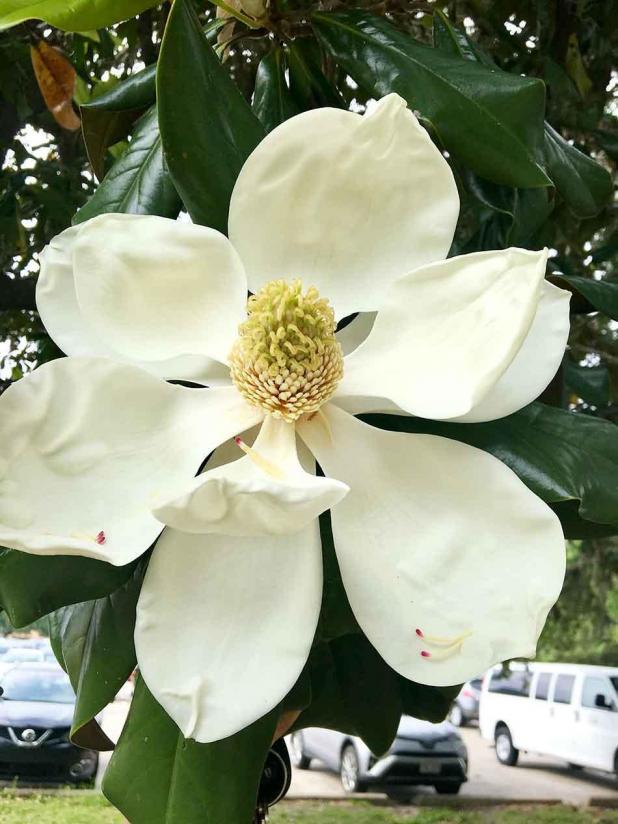
Southern magnolias produce striking blossoms
—LSU AgCenter/Heather Kirk-Ballard
Get It Growing: Magnolias are iconic Southern trees
Nothing describes the iconic Southern magnolia better than its given scientific name Magnolia grandiflora. Its flowers truly are grand, and most trees are now fully set with blooms filling the air with a wonderful fragrance and revealing large, white, showy flowers.
Because of its beauty, the magnolia blossom was designated the state flower of Louisiana in 1900 and was also one of 21 national tree candidates for the Arbor Day Foundation’s America’s National Tree contest. One fun fact about magnolias: The two oldest trees found on the grounds of the White House are two Southern magnolias that were planted by Andrew Jackson in the 1830s in memory of his wife, Rachel, who died two weeks after he won the election.
Magnolias are one of the most ancient and primitive of the flowering plant families with fossil records dating back 60 million years. Thought to predate the bee, these flowers were originally pollinated by beetles. Instead of nectar, the flowers produce large quantities of pollen that the beetles use for food. The flower bud is enclosed by a bract rather than sepals and has what are called “tepals,” a combination of sepals and petals similar in size and shape to water lilies.
According to the Magnolia Society International, there are more than 240 species of magnolias and thousands of cultivated varieties. Eight of the species are native to the United States. Two are evergreen, and six are deciduous. One of the most beautiful native evergreens is the Southern magnolia, growing throughout the South in lowland and coastal woods from Maryland and Virginia and sweeping all way to Texas in USDA hardiness zones 4 to 9. It grows best and is found naturally growing as an understory tree to pines in lowland areas, so it prefers part shade and requires a great deal of water in a rich soil that is porous and acidic. It can be found in sandy soils and sandy loams to clay loams.
The Southern magnolia is a relatively fast-growing tree that has a pyramidal, conical shape with a relatively straight trunk. It has been used extensively in landscapes in Louisiana, and some of the most common cultivars currently available include D.D. Blanchard, Bracken’s Brown Beauty and Alta. These trees can grow anywhere in height from 50 to 75 feet and 20 to 30 feet in width.
Dwarf cultivars can be used in smaller landscapes. The LSU AgCenter selected the dwarf cultivar Little Gem as a Louisiana Super Plant. It is also a Certified Louisiana Product. This cultivar is an excellent selection, growing half the size of the natives at 20- to 40-feet tall with a spread of about 8 to 16 feet. The foliage is an especially nice — glossy deep green leaves with brown undersides. The flowers are produced over an unusually long period, often appearing as late as October.
Teddy Bear is another compact-growing cultivar you will find in nurseries. It grows to be about 20-feet tall and 10-feet wide. Having a selection of cultivars allows you to pick one that has the characteristics you prefer, including size, shape, foliage characteristics and bloom season.
Sweet bay magnolia, also known as swamp or laurel magnolia, is also a native evergreen magnolia found abundantly in the coastal region of Louisiana, Mississippi and Alabama. It does well in a wide array of soils. It’s a smaller specimen tree and has dark blue-green leaves on top with a silvery-white underside. Flowers are small, creamy-white and bloom in late winter to early spring.
Some other great deciduous magnolias include saucer or oriental magnolia, yulan magnolia, star magnolia, loebner magnolia, umbrella magnolia, lily or tulip magnolia, cucumber tree or mountain magnolia, bigleaf magnolia, Ashe magnolia, Fraser magnolia and anise magnolia.
Some things to consider when planting: Magnolia trees make excellent shade trees; however, this can make growing grass and other under-plantings difficult. And although Southern magnolias are considered evergreen, the trees do drop leaves in late spring and early summer, much like the “evergreen” live oaks. The large, waxy and rather tough leaves decompose very slowly, but they can be chopped up with the mower and bagged and put back in the landscape to recycle nutrients. As flowers complete their bloom and die, they also drop old petals and rather large seed cones, so be aware of this when planting. In addition, magnolia trees produce large surface roots, so be sure to plant them away from sidewalks, driveways and slabs of home. Remember, magnolias use a great deal of water, especially as new plantings, and they do not do well if planted too deeply. Apply 2 to 4 inches of mulch in a “pitcher’s mound.”
